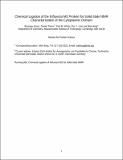Chemical ligation of the influenza M2 protein for solid-state NMR characterization of the cytoplasmic domain
Author(s)
Kwon, Byungsu; Tietze, Daniel; White, Paul Braden; Liao, Shu-Yu; Hong, Mei
DownloadHong_Chemical ligation.pdf (1.868Mb)
OPEN_ACCESS_POLICY
Open Access Policy
Creative Commons Attribution-Noncommercial-Share Alike
Terms of use
Metadata
Show full item recordAbstract
Solid-state NMR-based structure determination of membrane proteins and large protein complexes faces the challenge of limited spectral resolution when the proteins are uniformly [superscript 13]C-labeled. A strategy to meet this challenge is chemical ligation combined with site-specific or segmental labeling. While chemical ligation has been adopted in NMR studies of water-soluble proteins, it has not been demonstrated for membrane proteins. Here we show chemical ligation of the influenza M2 protein, which contains a transmembrane (TM) domain and two extra-membrane domains. The cytoplasmic domain, which contains an amphipathic helix (AH) and a cytoplasmic tail, is important for regulating virus assembly, virus budding, and the proton channel activity. A recent study of uniformly [superscript 13]C-labeled full-length M2 by spectral simulation suggested that the cytoplasmic tail is unstructured. To further test this hypothesis, we conducted native chemical ligation of the TM segment and part of the cytoplasmic domain. Solid-phase peptide synthesis of the two segments allowed several residues to be labeled in each segment. The post-AH cytoplasmic residues exhibit random-coil chemical shifts, low bond order parameters, and a surface-bound location, thus indicating that this domain is a dynamic random coil on the membrane surface. Interestingly, the protein spectra are similar between a model membrane and a virus-mimetic membrane, indicating that the structure and dynamics of the post-AH segment is insensitive to the lipid composition. This chemical ligation approach is generally applicable to medium-sized membrane proteins to provide site-specific structural constraints, which complement the information obtained from uniformly [superscript 13]C, [superscript 15]N-labeled proteins.
Date issued
2015-05Department
Massachusetts Institute of Technology. Department of ChemistryJournal
Protein Science
Publisher
John Wiley & Sons, Inc.
Citation
Kwon, Byungsu, Daniel Tietze, Paul B. White, Shu Y. Liao, and Mei Hong. “Chemical Ligation of the Influenza M2 Protein for Solid-State NMR Characterization of the Cytoplasmic Domain.” Protein Science 24, no. 7 (May 27, 2015): 1087–1099.
Version: Author's final manuscript
ISSN
09618368